Located on a once-abandoned lot, Chicago’s First Nation’s Garden thrives as a gathering space for the city’s 65,000 Native residents.
By Katie Scarlett Brandt
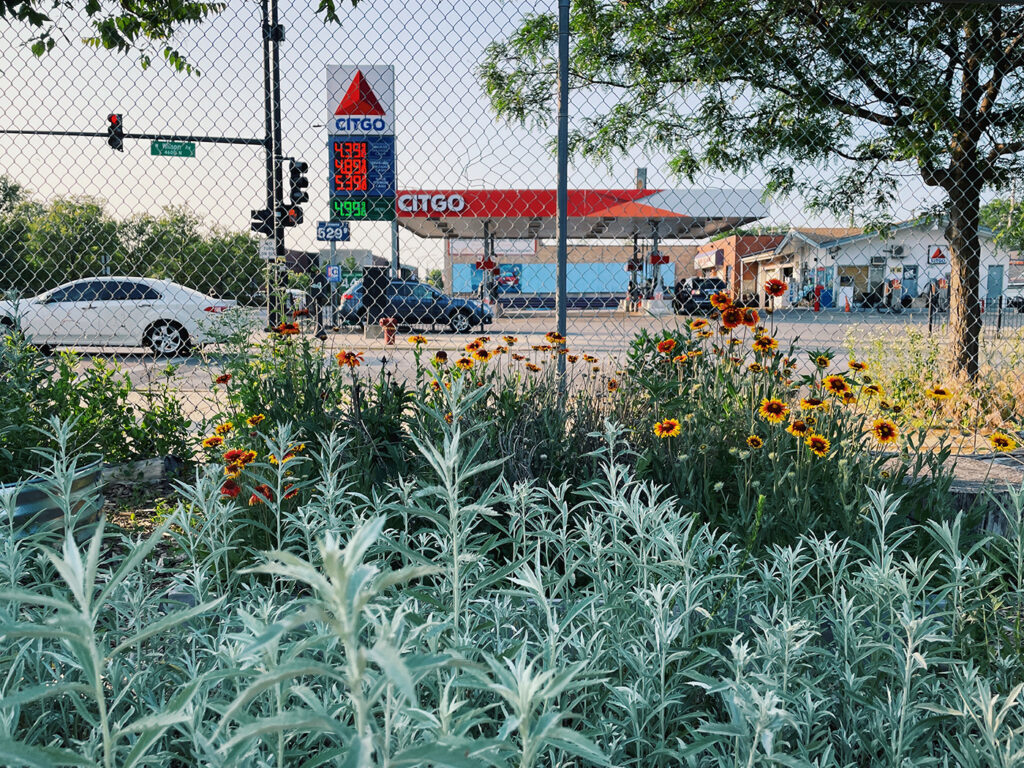
On an overcast summer Sunday afternoon, Janie Pochel, Saulteaux, was sitting under a makeshift shelter in the middle of the First Nations Garden in Chicago. She was waiting for rain, hoping for rain. Though the skies had looked threatening at times recently, they hadn’t offered more than a drizzle in weeks.
Pochel was worried about the garden — less about the native prairie plants, which have evolved over thousands of years in response to the regional weather, than about the vegetables and fruit growing in the garden’s 75 raised beds.
The First Nations Garden sits at the corner of two major streets — Wilson Avenue and Pulaski Road — on Chicago’s Northwest side, in the Albany Park neighborhood. A chain link fence encloses the 15,000-square-foot space. Along the Pulaski Road side hang a series of murals by Yankton Sioux artist David Bernie.
The murals create a privacy barrier while drawing attention to the Indigenous struggle for sovereignty. Behind the murals, prairie plants reach skyward. The Wilson Avenue side of the garden is primarily nursery plants. Across the street, lights from a Citgo gas station glow under gathering clouds.
Here, Pochel and the Chi-Nations Youth Council, the community group that manages the garden, have created a gathering space available to the Chicago area’s 65,000 Native people. Located in a neighborhood with one of lowest tree canopies in the city, the garden also partners with organizations to host educational events.
“People really wanted green space,” Pochel said, though the Youth Council had to push hard to get control of the space. But, she added, “It’s not just a garden.”
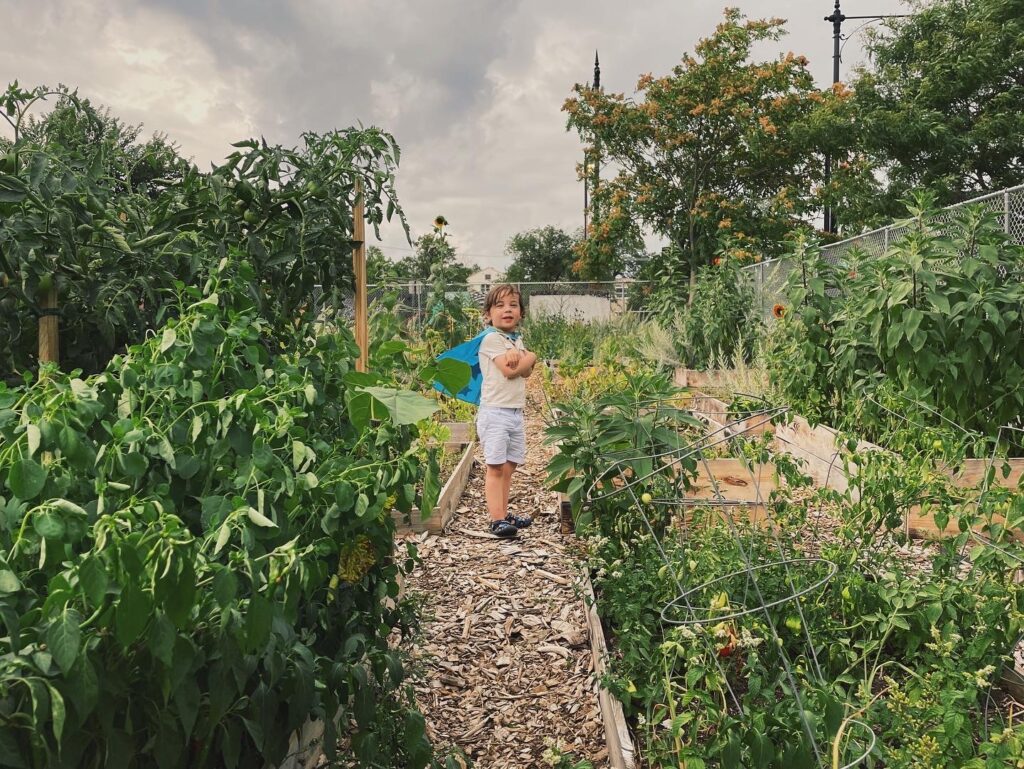
Samantha Garcia, Lac Courte Oreilles Ojibwe, lives near the garden. “A couple years ago they invited people to work days — help cleaning up, trying to cover their wigwam,” Garcia said. “I went for that, did what I could. I’ve dropped off Christmas trees after we’re done with them because they use it for firewood.”
As an organizer behind the First Nations Film and Video Festival in Chicago, Garcia also has partnered with the First Nations Gardens for film screenings. “They do so much of their own work, and they’re going to exist regardless for their own purpose. Because of that, a lot of people want to collaborate with them.”
Recent collaborators have included North Park University and the Chicago Park District, who hosted a Monarach-a-palooza at the garden to educate people about the value of monarch butterflies as pollinators. The Youth Council capitalized on the event by exposing people to the native prairie plants growing in the space. “People love butterflies, so let’s put them on road to loving natives,” Pochel said.
The garden initially fell in Alderman Carlos Ramirez-Rosa’s 35th ward, though redistricting recently switched it to the 33rd ward. Ramirez-Rosa said he sees the value in the garden and in these partnerships. “It’s a wonderful, beautiful community asset. I think it’s so important that Native people reclaim land, that urban youth have a place to gather and learn.”
Pochel and the other organizers make the work look easy. There’s no shortage of events — from stick games and storytelling in the winter to barbecues in the summer. But it took a lot of effort to get what was an abandoned lot to its current lushness.
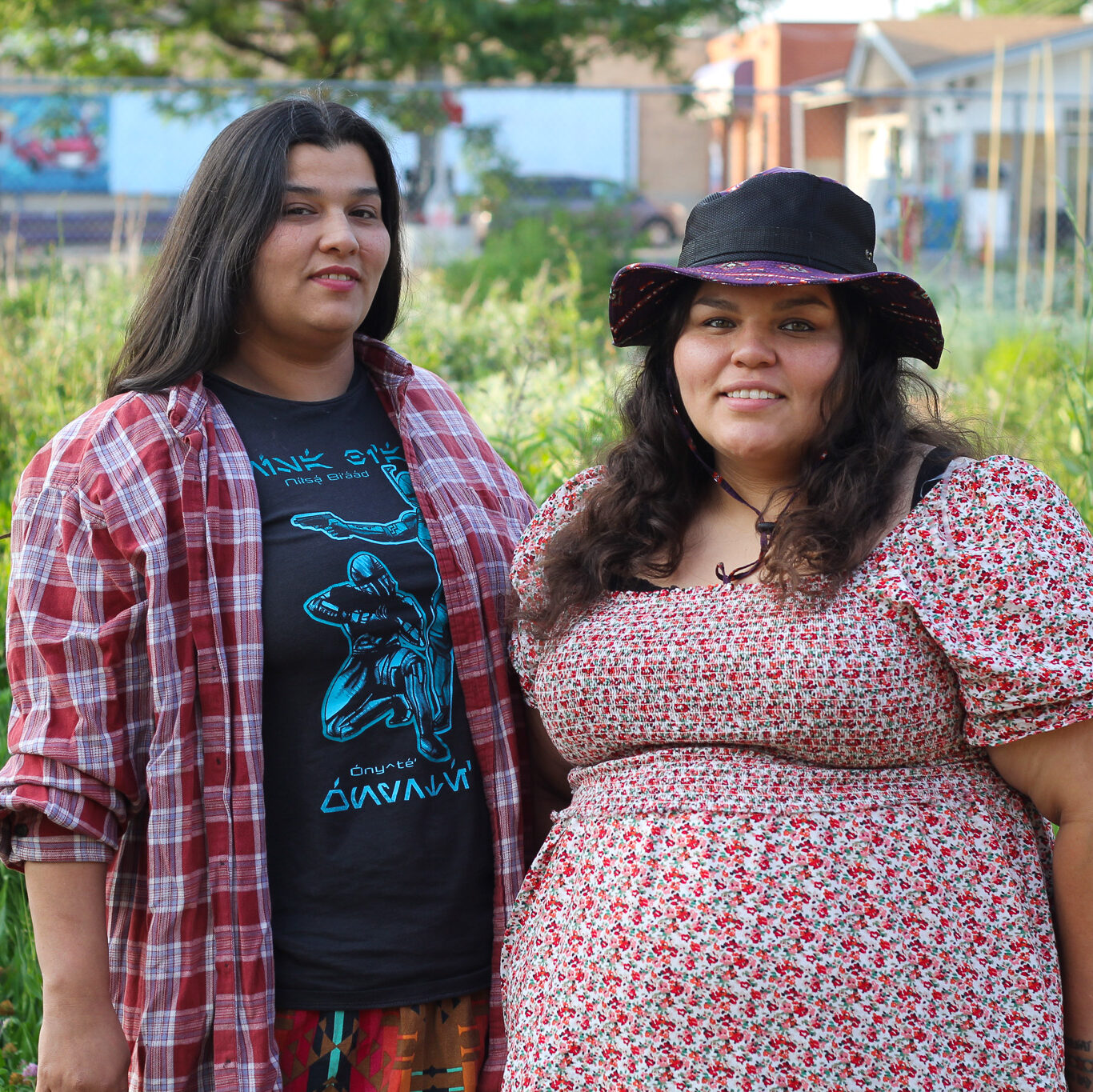
Building community
In November 2018, the Chi-Nations Youth Council took over the abandoned lot that locals had been using as an unofficial dog park. Feces, trash, and rats overran the space. But a core group of 15 people, ages 7 to 80, dedicated themselves to clean-up, Pochel said. They focused one month on clearing garbage and another on bringing in soil, boulders, and plants, using a tipi to flatten land as needed.
Once the group had cleared the lot, they began building raised beds. Leading up to the pandemic, the garden had six beds. Now, it has 75 — all full, with about half for neighborhood gardeners and half for Native gardeners from throughout the city.
“Where we are now is where we thought we’d be in seven years,” Pochel said.
The pandemic created an opportunity for people to spend more time at the space, with their hands in the dirt. They focused on growing native plants, food, and improving the soil quality. The Youth Council also received a $15,000 grant from the Indigenous Environmental Network to support the garden’s development.
Occasionally, small conflicts and acts of overt racism, especially when the tipi is up, cause annoyances. “It’s people coming by and being openly racist to us or not realizing it’s racism,” Pochel said.
Ramirez-Rosa said his office fielded some negative feedback, too. “Early on, we had some complaints from some neighbors. Overall, people have looked to the garden as something that’s inspirational and have had so many wonderful community events there.”
Conserving water and restoring the soil
Now, gardeners face two main challenges in nurturing an urban garden in the third-largest U.S. city: soil quality and water access.
The garden doesn’t have running water, so the Youth Council plants intentionally, uses rain barrels, and hauls water. Individual gardeners are responsible for providing their own water, but also have access to the space’s rain barrels.
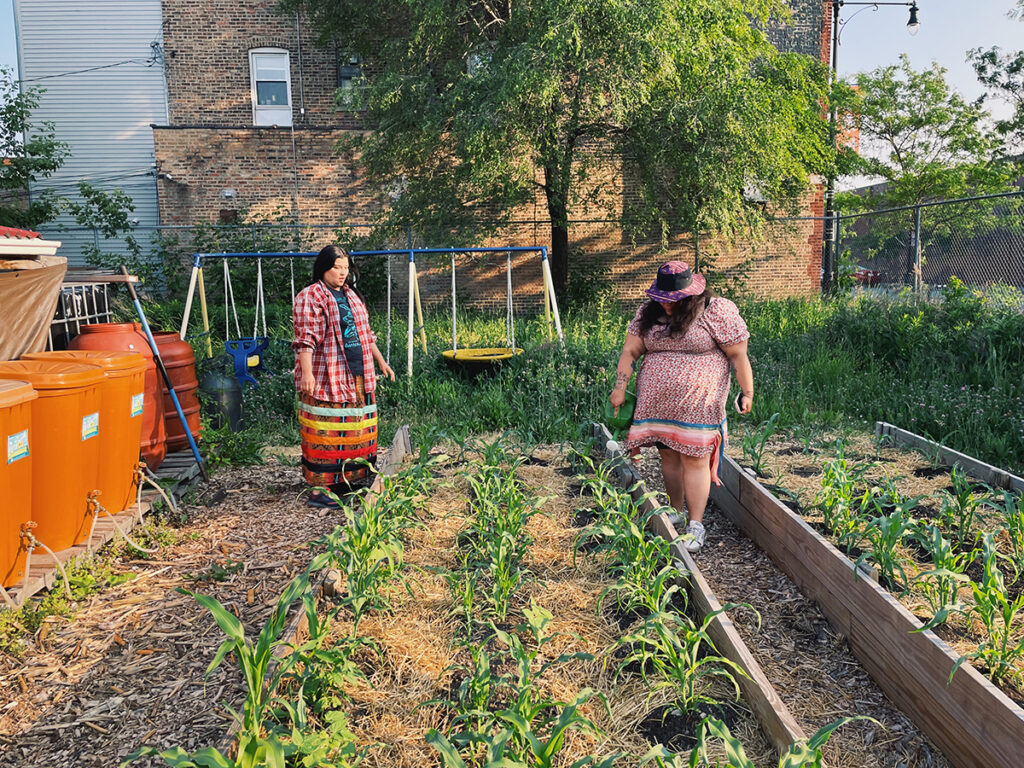
“We’re trying to get the plants used to not having water. Since a lot are native plants, we want them to be adapted to the climate here. The corn and tomatoes — those are the only things we have to haul water in for,” Pochel said.
Along one side of the garden, squash, beans, and corn grow together in a traditional, mutually beneficial growing technique called “the three sisters.” The squash spreads its broad leaves to create shade, while the beans add nitrogen to the soil, and use the tall corn stalks as poles.
The corn came to the garden from a tribe in Minnesota, and though it came with instructions, Pochel moreso keeps in tune with the plant itself. “Plant the seeds, and the corn will teach you,” she said.
The same goes for other plants throughout the garden. While the land has a general layout — prairie plants along one side, raised beds on the other — Pochel said, if plants start growing on their own somewhere, the gardeners don’t interfere. “When a plant introduces itself, we know it wants to be here, so we try to take care of it.”
The approach seems to be working. This past year, Pochel said they counted 40 Native pollinators among the plants.
Additionally, the Youth Council made traditional mounds — what look like small hills of soil with plants growing in a ring from peak to base. The mound creates a reservoir from which the roots draw water and helps the plants better store that water. Soil quality poses another major challenge. Chicago soil is notorious for high lead levels, thanks to decades of lead in construction and gasoline, the latter of which wasn’t officially banned for vehicles until the Clean Air Act of 1996, (though unleaded gas was widely available by 1975). Lead is a neurotoxin, linked with developmental delays and increased violence in children and young adults. It also causes kidney and heart damage in adults.
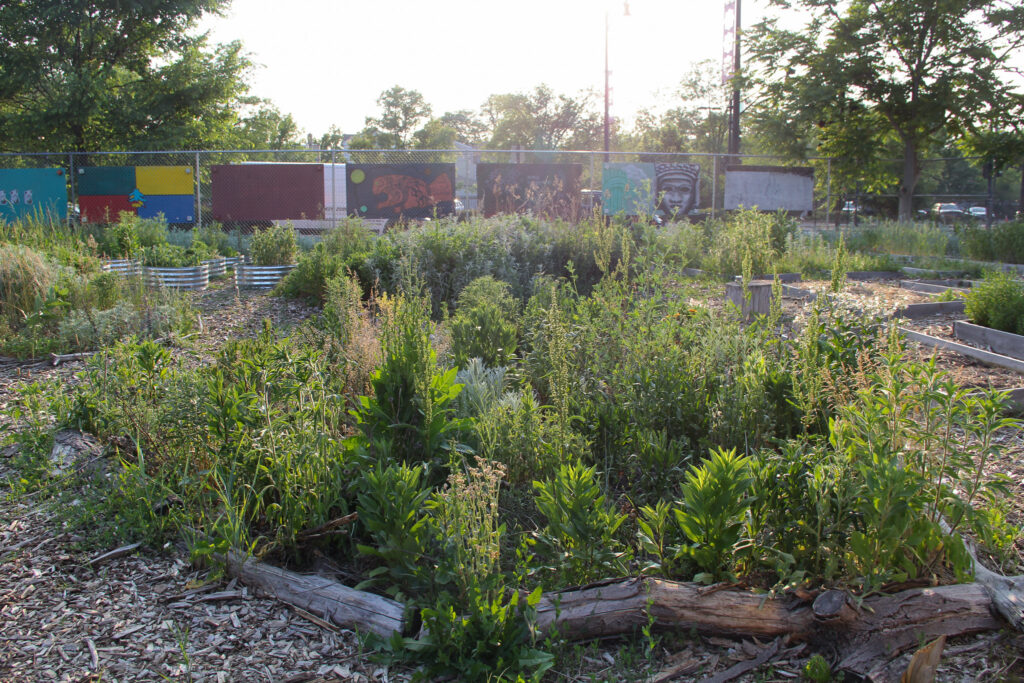
Because of the lead, Pochel said, “All the plants that are in the ground are not fit for human consumption. That’s why we have the raised beds.”
The city donated waste soil to the garden, which the gardeners have used for planting non-edible prairie plants that help with remediation. For the raised beds, gardeners haul in planting soil, to ensure the foods are safe to consume. The Youth Council had the general soil tested in 2019 and will test it again this year, after four years of phytoremediation.
One-third of the garden is devoted to phytoremediation, Pochel said. Gardeners have planted sunflowers, mint, and sage, which take up and store heavy metals in their leaves. While this makes the leaves unusable, the seeds remain safe to consume. As an added bonus for a city garden, mint and sage also repel rats.
Looking for support from the city
Early in 2022, the Chi-Nations Youth Council petitioned Chicago’s Department of Planning and Development to make the garden permanent. This would not only safeguard the land from developers, but the city would bring the land up to food-quality growing standards, supplying healthy soil. The garden would also receive a hydrant for running water.
“The goal is to get them funding to make continued improvements for the site and make that permanent. Part of the funding is for soil remediation and for permanent water access,” Ramirez-Rosa said.
Part of turning over that space would involve uprooting the plants to install the new soil. Pochel isn’t sure when or if it will happen — and even though it would be a large project, it could occur with very short notice. “We’re emotionally ready,” Pochel said, about the potential of having to relocate or even lose some of the plants.
Whatever happens, Garcia said she knows the garden will persevere. She’s seen that already. “I’ve seen it evolve, and I love that it’s in my neighborhood. I like that they make it really accessible, at least to me. I want to say everyone, but I’m friends with Janie on Facebook, and she posts about all of the stuff that they’re doing, events that they have. It’s cool to have access to it in that way.”
Thanks to the committed efforts of Pochel and her fellow gardeners, that access will grow, just as the garden has, for years to come.
• • •
Katie Scarlett Brandt is a freelance writer based in Chicago.
Story published July 11, 2023
• • •
Enjoyed this story? Enter your email to receive notifications.
